Wands are an ESSENTIAL COMPONENT FOR ALL ADEPT SPELLS
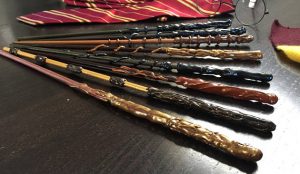
The wand is the Adept’s focus and it replaces many material components in spells and the finger movements are replaced with wand gestures. Verbal command words and syllables are still generally used.
An Attuned Wand extends the Adept’s Touch for delivering touch spells. Including the Adept’s Detect Magic Touch and attack spells that involve touch.
A Note About Saving Throws: Since ALL Adept spells are cast using Wands, Rods or Staves, MOST saving throws vs Arcane Magic are made using the ROD/STAFF/WAND column.
Each Adept caster MUST have his/her own ATTUNED wand. An Adept has only one wand at a time, though the Adept may elect to make a new one of a different style at any time. Once the new one is attuned to the Adept the old one loses functionality.
The choice of form or style between Wand, Rod or Staff is up to the Adept. There are advantages and disadvantages to each type. When Attuning a new wand an Adept may opt for a different form.
A Wand is made primarily of wood, bone, antler, ivory or other organic material and measures 10” to 18” in length. Wands are usually carried in a sheath or scabbard when not in use. Or encased in a cane similar to a Sword Cane. They are somewhat vulnerable to breakage (compared to a Rod or Staff) but it usually is only a problem in the event of a fall. They are the easiest to conceal and when sheathed leave both hands free (unless part of a cane.) Wands add +1 to Hit rolls for Aimed Missile or Ranged spells.
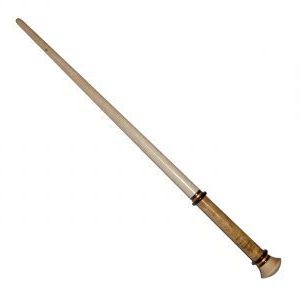
Light and easily concealed under a coat, jacket or other clothing. The Adept’s Wand is valuable if you want to keep your hands free for other purposes.
Keppen Wand (which means ‘Cunning Wand’) is a short, about 5 to 7 inches, pocket sized wand. Commonly made from Rowan wood, though carved pieces of bone are not uncommon. It is intended to be kept in the pocket of a skirt, up a sleeve or similarly concealed. Their short, stubby nature means that they are less likely to break in the event of a fall, but they do not give any aiming benefit. They can be used for Touch Attacks and similar spells, but the Adept’s hand is VERY close to the target!
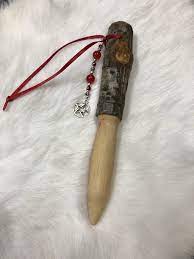
Keppen Wand of Rowan wood
A Rod is made primarily of wood, bone, antler, ivory or other organic material and measures 24” to 48” in length. Most Rods correspond in general size (length and diameter) to a walking stick, cane or baton. They can be employed as such in melee combat as a light club (providing the composite material is inherently strong enough.) The walking stick is a common fashion item for gentlemen as well as being a discreet defense weapon.
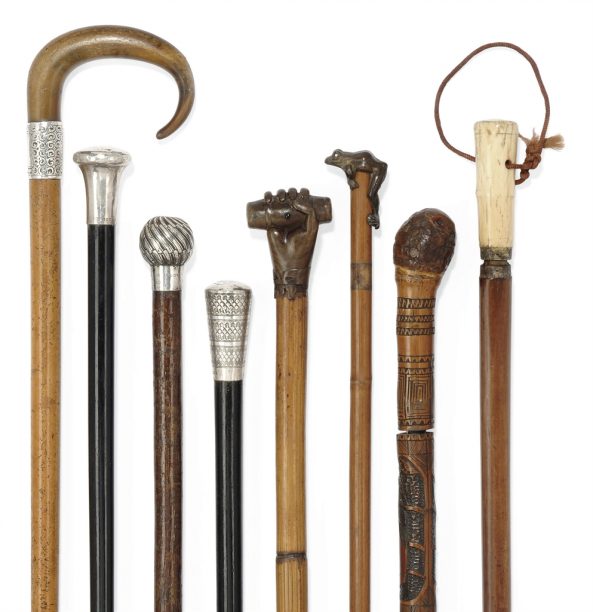 An Adept’s Rod can easily pass for a fashionable and stylish walking stick.
An Adept’s Rod can easily pass for a fashionable and stylish walking stick.
A portion of the Rod can be made to serve as a scabbard (similar to a Sword Cane) although the blade cannot be more then about a third of the Rod’s overall length. Typically 8″ to 12″ (Large Dagger.) They can also be incorporated into an umbrella or parasol.
A Staff is is made primarily of wood, bone, antler, ivory or other organic material and measures 5′ to 6′(+/-) in length. A Staff can be employed in melee combat as a ‘staff’ (providing the composite material is inherently strong enough.) A staff is more common in rural environments, especially in rugged terrain where they are a climbing/hiking aid. It is very unusual to see them about town or indoors.
A staff can be crafted to fit a detachable blade, like a socket bayonet. This allows the Adept to use the staff like a spear, stabbing/thrusting only (NOT as a missile weapon.) Having a blade permanently mounted is possible, but would be socially unacceptable in most situations.
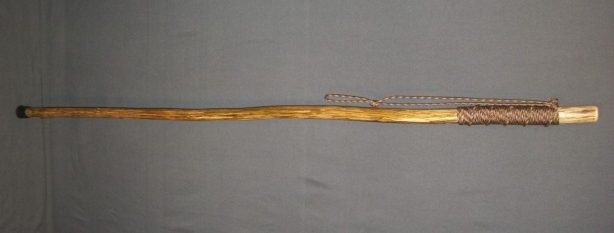 The Staff can be very simple or ornate, but is generally a feature of rural life and out of fashion in the city.
The Staff can be very simple or ornate, but is generally a feature of rural life and out of fashion in the city.
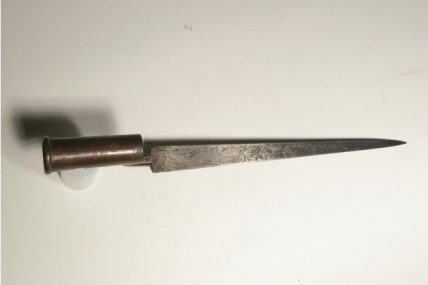 The blade can be attached to an Adept’s Staff.
The blade can be attached to an Adept’s Staff.
Attunement Spell
Attunement (Wand,Rod,Staff) (Alteration)
Level: I Components: V S, M ,
Range: Touch Casting Time: I day to cast, 1 week to complete
Duration: Permanent
Saving Throw: None
Area of Effect: One object
Explanation/Description: Used by an Adept to Attune or prepare a wand, rod or staff for spell casting purposes.
Casting time is 24 hours of handling, touching and preparing the chosen wand, rod or staff. Preparing encompasses sanding, smoothing, carving, shaping, oiling and or finishing the material as desired. The spell is then cast and the wand is placed in a glass bottle, bowl or dish to soak in and absorb the elixir (see below) for at least one week.
The selected material for Attuning must be of organic material and fall into the size ranges specified for the type. Organic materials include wood, bone, horn, antler, ivory, chitin and various reeds or woody grasses. There may be some non organic adornment. Jewels, inlays, metal ‘foot’ for wear purposes or to strengthen the base material… But the bulk of the wand, rod or staff must be exposed and uninterrupted organic material for its length. Rowan wood is considered the best wood for a Wand, Rod or Staff. Hickory, Holly, Oak and Ash are also good choices and are usually easily obtained.
Wand Elixir: This formula must be made fresh for each wand attuned. The principal ingredient is fresh, clean, water. Either taken directly from a spring or caught as rain water. (Note: London rainwater is NOT clean! There is too much soot in the air.) The second largest ingredient is blood from the Adept. This, absorbed into the wand as it soaks, is what ‘Bonds’ and attunes the Wand to the Adept. A variety of Salts, Minerals, herbs and other organic materials are also mixed into the elixir. The resulting solution must be enough to completely surround and engulf the wand, rod or staff while it is in the bath. A wand will require at LEAST 1 pint of spring water and 4 ounces of the Adept’s blood (1pt damage to Constitution) along with about $3 of other ingredients. A rod will typically require a minimum of a quart of fresh water and 8 ounces of the Adept’s blood (2pts damage to Constitution) and $6 of other ingredients. A staff will require a half gallon of water, 16 ounces of the Adept’s blood (4pts damage to Constitution) and $12 of other ingredients. NOTE: The quantity of blood used and its personal cost, is one of the reasons that Adepts generally use wands and not staves. Also, a suitable container to soak the item in, which can be sealed for storage and evaporation, is harder to find and of greater expense for the larger rods and staves. A clean wine or champagne bottle will do for most wands and can be broken (at little cost) to extract the wand. While large urns may be big enough for a rod, the amount of water, and especially blood, needed to immerse the rod becomes prohibitive. Ideally a long, narrow, glass vessel, like a test tube, is needed to contain the wand. Such a vessel will not be cheap. Similarly, a staff requires an even larger container, or substantially more blood from the Adept! These containers MUST be of glass or glazed porcelain or earthenware. The salts and blood in the formula will react with any other material (except gold) and ruin the wand.
Any spell that requires a common material component substitutes a properly prepared and Attuned Wand, Rod, or Staff for those components. Additionally, gestures of the fingers, hands and body are replaced with gestures employing the Wand, Rod, Staff. An Attuned Wand, Rod or Staff extends the Adept’s Touch for delivering touch spells. Including the Mage’s Detect Magic Touch. For example, a Shocking Grasp spell attack may be cast through the Attuned Wand, Rod or Staff.
NOTE: If the Attuned item is itself attacked by a Touch based attack, for instance Strength Drain, and the Mage is holding the item, the attack WILL pass through to the Mage.
Attuned Rods and Staffs may be used as general melee weapons without affecting the items Attuned function. However, an Attuned Rod or Staff used thus does not enhance attacks or damage and is NOT considered an enchanted weapon for the purpose of hitting a creature struck only by magic weapons.
Wands are too light and fragile to be used as a melee weapon. However they do enhance Aim (+1 to hit) for ranged attacks. This is NOT considered an enchanted weapon for the purpose of hitting a creature struck only by magic weapons.
Attuned Wands, Rods and Staffs may be further enchanted without affecting the Attunement.
The duration of the Attunement is permanent until the Wand, Rod or Staff is broken, lost, discarded or destroyed.
Attunement is unique between an Adept and his/her Wand, Rod or Staff. A Wand, Rod, Staff cannot be shared, nor can another Adept’s Attuned device be used successfully.
Though an Adept may have several attuned Wands, Rods and Staffs prepared and stored in reserve. (The device must remain suspended in its Elixir bath until the Adept wants it.) The Adept can only have ONE in active use. If the Adept removes a new wand from its Elixir Bath, his/her old wand loses Attunement.
If someone else removes the wand from the Elixir Bath, the Adept’s connection to his/her existing wand is unaffected but the ‘new’ wand loses all of its developed attunement and is useless to its creator.
